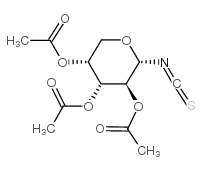Inhibitory effects of wasabi isothiocyanates on chemical mediator release in RBL-2H3 rat basophilic leukemia cells.
Tomoe Yamada-Kato, Masashi Nagai, Motoko Ohnishi, Kazutoshi Yoshida
Index: J. Nutr. Sci. Vitaminol. 58(4) , 303-7, (2012)
Full Text: HTML
Abstract
Wasabi is a plant of Japanese origin. It belongs to the family Brassicaceae and produces various isothiocyanates (ITCs). To clarify the type I allergies inhibited by wasabi ITCs, we investigated the inhibitory effect on chemical mediator release from dinitrophenylated bovine serum albumin (DNP-BSA)-stimulated RBL-2H3 rat basophilic leukemia cells. Allyl ITC (AITC), sec-butyl ITC (s-BuITC), and 3-butenyl ITC (3-BuITC), which have 3 or 4 carbon chains, inhibited histamine release but did not inhibit the release of leukotriene B4 (LTB4) or cysteinyl LTs (CysLTs). 4-Pentenyl ITC (4-PeITC) and 5-hexenyl ITC (5-HeITC), which have 5 or 6 carbon chains and an unsaturated bond at the end, inhibited LTB4 release but did not inhibit the release of histamine or CysLTs. 6-Methylthiohexyl ITC (6-MTITC), 6-methylsulfinylhexyl ITC (6-MSITC), and 6-methylsulfonylhexyl ITC (6-MSFITC), which have a sulfur atom inserted at the end of a 6-carbon chain, inhibited the release of histamine, LTB4, and CysLTs and the elevation in intracellular Ca(2+). These results suggest that wasabi ITCs inhibited type I allergies by inhibiting chemical mediator release and that the inhibitory effects on each chemical mediator were due to differences in the side chain structure of the wasabi ITCs.
Related Compounds
| Structure | Name/CAS No. | Molecular Formula | Articles |
|---|---|---|---|
 |
2,3,4-tri-o-acetyl-alpha-d-arabinopyranosyl isothiocyanate
CAS:62414-75-9 |
C12H15NO7S |
|
Neural peptidase endothelin-converting enzyme 1 regulates en...
2014-06-01 [J. Clin. Invest. 124(6) , 2683-95, (2014)] |
|
Transient receptor potential ankyrin 1 receptor activation i...
2014-01-01 [PLoS ONE 9(5) , e97005, (2014)] |
|
Corneal sensory nerve activity in an experimental model of U...
2014-06-01 [Invest. Ophthalmol. Vis. Sci. 55(6) , 3403-12, (2014)] |
|
Transient receptor potential ankyrin-1 (TRPA1) modulates sto...
2013-12-01 [Biochim. Biophys. Acta 1833(12) , 3025-34, (2013)] |
|
Effects of acid on vagal nociceptive afferent subtypes in gu...
2014-08-15 [Am. J. Physiol. Gastrointest. Liver Physiol. 307(4) , G471-8, (2014)] |